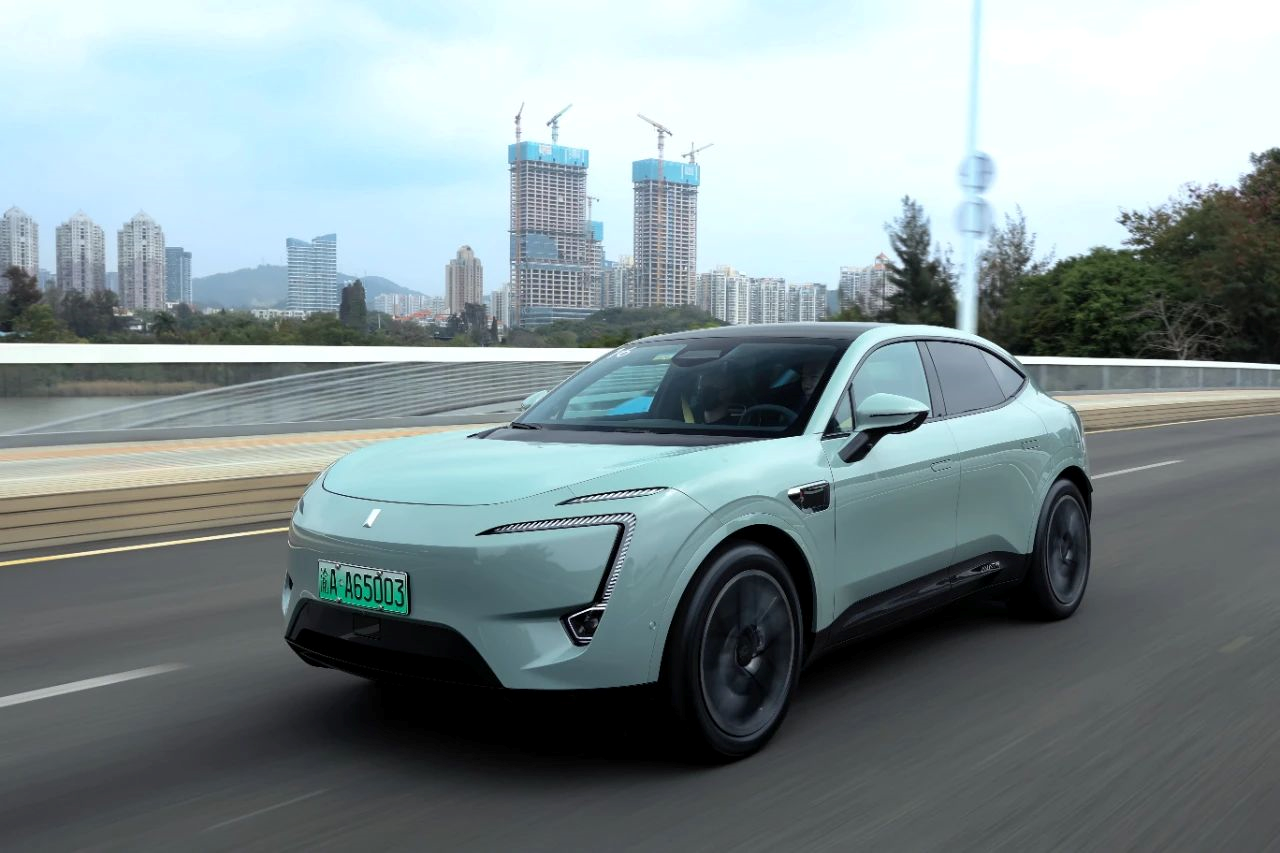Author | Zhu Shiyun
Editor | Qiu Kaijun
In the current car market’s “price war,” Aveta has chosen a more difficult but more enduring path.
On March 24, Aveta 11 single-motor version was officially launched. Compared with the entry-level price of the dual-motor model dropping by 30,000 yuan, the long-endurance single-motor version retails for 319,900 yuan, and the ultra-long-endurance single-motor version retails for 349,900 yuan.
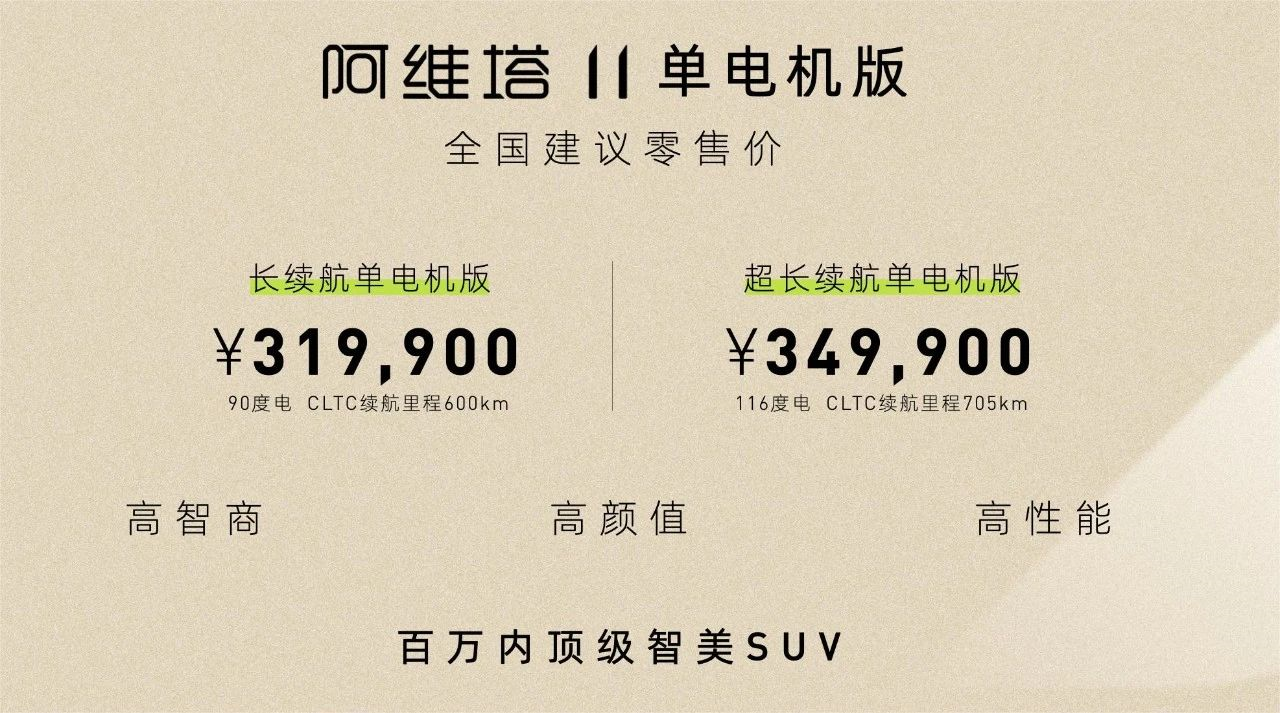
It is noteworthy that this single-motor model still comes equipped with the HiHuawei full-stack intelligent car solution across the board, with 34 intelligent driving sensors as standard, including three laser radars – which also gives the Aveta 11 the ability to upgrade to Huawei’s latest generation of intelligent driving system (ADS 2.0) via OTA in the future.
If cost reduction is the only consideration, a high-quality electric motor costs about $1,000, while a laser radar costs about $8,000. At present, reducing laser radars is the “wise” way to respond to the current price war, as intelligent driving functions have not yet been fully commercialized.
But in the eyes of Aveta CEO Tan Benhong, “advanced intelligent driving is a strategic anchor for Chinese cars to occupy the future in the medium-to-long term, which will be difficult, challenging and controversial. But in order to see the future because of believing in the future, leaders must do difficult things.”
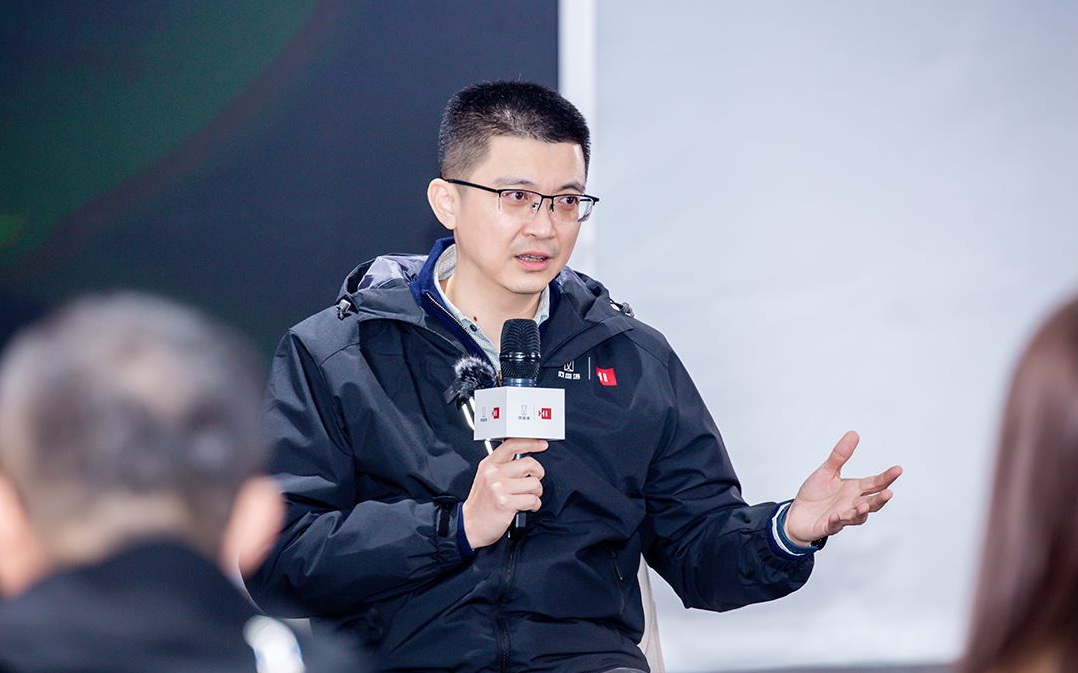
Why did Aveta design the Aveta 11 single-motor version with such features and is it a reasonable choice for consumers and even Aveta itself?
Keeping intelligence to increase endurance, Aveta confronts price war
Aveta set lofty goals but did not underestimate the fierce market competition.
Aveta 11 single-motor version has an entry-level price of 319,900 yuan, which can be stacked with multiple time-limited benefits such as a 10,000 yuan full-payment purchase discount, a 6,000 yuan insurance subsidy, and a 5,000 yuan deposit discount, directly competing with the top model of Tesla Model Y.### 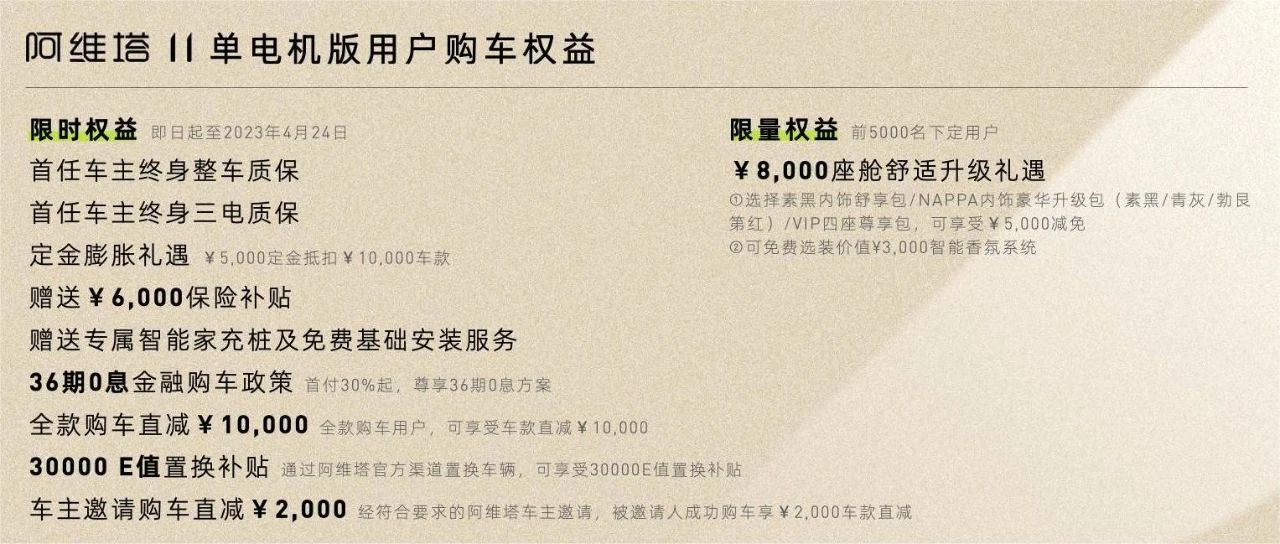
On the configuration side, the Avita 11 retains many characteristic product functions that embody the brand label, except for one motor, a tail wing, and an electric suction door.
First of all, it is equipped with the HI Huawei full-stack intelligent car solution, including 3 LiDAR, 6 millimeter-wave radar, 13 high-definition cameras, 12 ultrasonic radars, and the Huawei MDC810 computing platform. It also includes the NCA high-speed navigation function that comes with delivery.
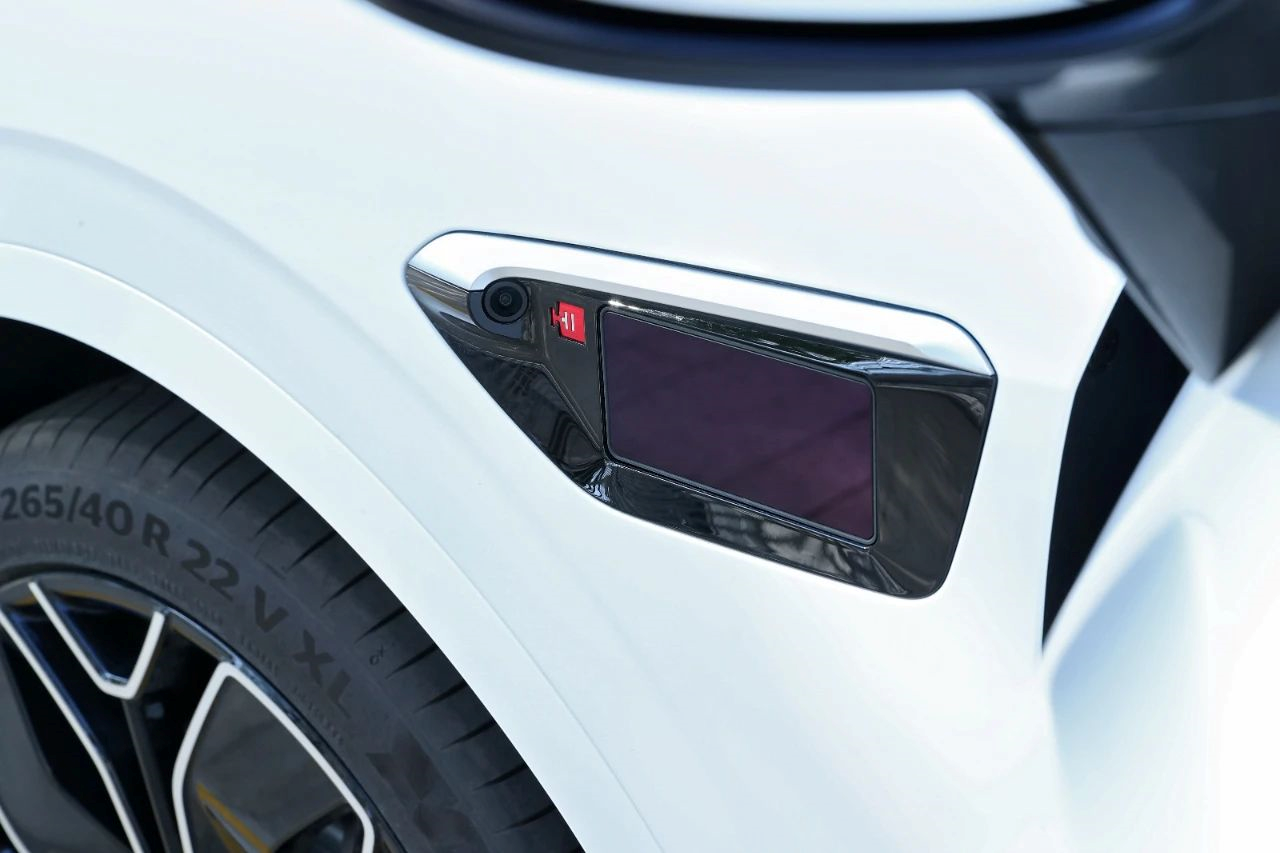
It also still provides 90-degree and 116-degree batteries, which can achieve a comprehensive cruising range of 600 kilometers and 705 kilometers under the CLTC working conditions. The 750V high-voltage platform can add 200 kilometers of cruising range in 10 minutes at a 240 kW supercharging post. It takes 25 minutes to charge 0-80\%, which provides 480 kilometers of cruising range.

“In my over 20 years in this field since 1998, I have never encountered such an intense price war. However, Avita believes that a stable pricing system is the core standard for evaluating brand power. Lowering prices in a light-hearted manner is not beneficial for a new brand. We adhere to the long-termism of the intelligent car market and dare to bear short-term pressure.” Tan Benhong stated, “The Avita 11 single-motor version gives users a choice of longer cruising range without compromising the intelligent driving experience. This shows our determination to remain in the high-end intelligent electric vehicle market and the confidence of Avita’s brand leadership in the new market.”
Since its delivery in late last year, over 6,000 Avita cars have been delivered as of March 24th. In February, Avita 11 reached 1,375 units, becoming the second among pure electric SUVs above 300,000 RMB.## Behind the Single Motor: Avita’s Value Proposition
Price wars are questioning all players: how much is your car really worth?
The current price war essentially stems from severe supply-demand mismatch in the short term: on the supply side, there is a surplus of fuel production capacity and homogeneity in intelligent electric vehicles; on the demand side, consumers of fuel vehicles worry that they have bought the last batch of “Nokias”, while consumers of intelligent electric vehicles are concerned about “prepaid fees”.
Essentially, these worries are all questioning the value of automotive products – with the rise of intelligent electric vehicles, how will performance and intelligence reshape the value of automobiles?
In terms of power, the Avita single motor version is already able to provide high-end power performance of fuel vehicles – with 230kW of power, it can rival the power of 3.0T models of luxury SUVs of mainstream brands such as Porsche Cayenne, Mercedes-Benz GLS, BMW X5, Audi Q7, and Land Rover Range Rover.
This is precisely the core reason why Chinese new energy brands such as NIO, Ideal, and Avita are aiming to replace the traditional luxury fuel vehicle market – electric drive technology can easily match the core value barrier of power performance of luxury fuel vehicles.
But matching is not enough; intelligentization is the key factor that differentiates Chinese new energy vehicle companies such as Avita from traditional luxury brands and adds luxury value.
“Certain products such as TVs, refrigerators, and sofas can boost sales, but they certainly cannot boost brands.” Tan Benhong believes that intelligent driving is the anchor point for Chinese brands to transform from the old to the new and from the past to the future, and achieve overtaking on bends. “Using advanced intelligent driving to consolidate our brand is not a speculative action, but a strategic choice.”
Thus, it is not difficult to understand why Avita insists on providing HI Huawei’s full-stack intelligent automobile solution as a standard configuration this time.
High-specification hardware as a standard configuration provides product support for Avita’s “intelligent driving ceiling” brand label.
More importantly, the standard configuration of intelligent driving hardware systems means that a uniformly high-quality data structure can maximally and economically drive high-speed rotation from sales to data to system iteration.
“I’m now fully committed to the intelligent driving track. In the future, whether it’s functional experience, cost, or efficiency, we will further break through and become the leader in the “IPHONE moment” of intelligent driving.” Tan Benhong said that Huawei’s ADS2.0 system will be unveiled in April, and on this basis, Avita will launch non-high-precision map solutions for intelligent driving as early as this year.## Behind the Three LiDARs: Reserved Values for Intelligent Driving
“Intelligent driving makes leading the marathon easy.”
On March 19, the Autocar11 single motor model appeared as the lead vehicle for the Chongqing Marathon.
It’s worth noting that the Autocar11’s navigational process was entirely accomplished by a high-level intelligent driving system, with the human driver only present as a safety officer.
“The road conditions of the competition were very smooth, so it was easy for the machine to lead. But in abstract, this is still a process of replacing humans with machines, so there are still some epoch-making implications.” said Tan Benhong.
Being able to lead a marathon race in the city reflects one of the advantages of the Autocar11 in the price war: the widely available city navigational function.
Starting in March, Autocar has been offering users the chance to test-drive the NCA intelligent driving navigation assistance in urban areas in Shanghai, Shenzhen, and Guangzhou. Chongqing will soon be available for testing as well. Autocar will push NCA to users in the four cities, and by then, the Autocar11 will be the mass-produced vehicle with the most advanced, all-scene high-level intelligent driving capability in China.
The intelligent driving system currently installed on the Autocar11 is expensive, but it remains an essential part of the product’s value proposition. The rapid deployment of this widely available high-level intelligent driving capability has turned a pre-paid future for consumers into an actual delivery.
Based on the current test-driving experience, Autocar11 provides users with a reliable human-machine co-driving experience, and the three LiDARs provide significant gain for the intelligent driving system on urban roads with poor high-precision maps, ensuring their “existence value.”
The Autocar11 NCA intelligent driving navigation assistance covers all typical urban scenarios like unprotected intersections, congested sections with follow-up stops, close-range overtaking and jamming handling, and active overtaking and lane-changing.
With accurate identification and efficient prediction, Autocar11 has achieved the “veteran driver” style of driving in Chinese characteristic scenarios, such as the intersections of mixed motor vehicles, electric bicycles and pedestrians, turning from the same direction on multi-car and multi-directional intersection roads, and avoiding strange obstacles like water horses, piles, and tanks flexibly and independently.
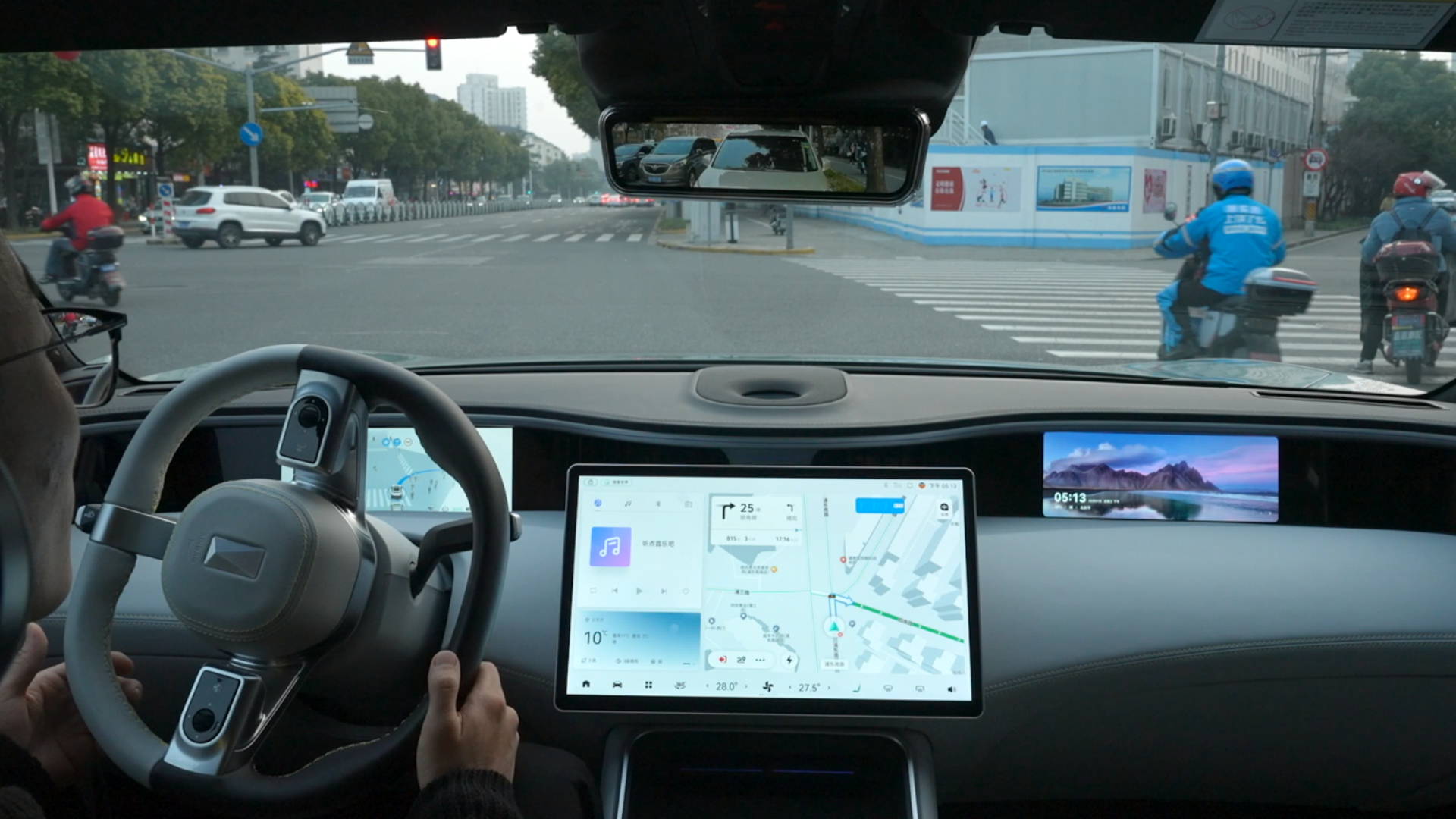 The widespread implementation of these abilities is especially important for Avita11 at present. Providing a good human-machine driving experience in cities will not only reduce risks and alleviate fatigue for drivers, but also encourage more frequent use of the system and accumulation of data. Additionally, the word of mouth effect will further boost Avita11’s sales and transform the company’s strategic reserves into important selling points.
The widespread implementation of these abilities is especially important for Avita11 at present. Providing a good human-machine driving experience in cities will not only reduce risks and alleviate fatigue for drivers, but also encourage more frequent use of the system and accumulation of data. Additionally, the word of mouth effect will further boost Avita11’s sales and transform the company’s strategic reserves into important selling points.
The long-termism behind ALL IN intelligent driving: Avita
In the current situation where intelligent driving technology faces commercial challenges, every enterprise that emphasizes intelligent driving is under heavy pressure. Some choose to survive first, while others choose to continue to adhere to ALL IN intelligent driving–“We must see because we believe, not believe because we see. China’s automobile industry really needs to overtake, occupy the future and become the new leader,” said Tan Benhong.
Avita’s ALL IN intelligent driving is not only a strategic choice but also a testament to its own technical confidence.
Built upon four redundant hardware perception systems, including vision, millimeter-wave radar, LiDARS, and ultrasonic waves, and the 400 TOPS Huawei MDC810 computing platform, the fusion perception and interactive game algorithm implemented on the Avita11 is at the forefront of the current players.
Although various car manufacturers have perception hardware such as vision and LiDARS, there is a significant difference in actual perception levels, which is due to the gap in grasping different hardware characteristics and multi-modal fusion technology.
Avita’s fusion perception algorithm reasonably arranges sensor confidence levels for different scenarios and efficiently applies algorithms to accurately identify the movement and posture of dozens of surrounding targets through Huawei’s vertically integrated computing and perception hardware.
In the challenging prediction and decision-making segment when “entering the city,” Avita’s interactive game algorithm has gone one step further compared to the previous industry-wide approach of using one set of decision-making standards to deal with all situations.
For example, when merging, if the game object is a small car, Avita will be more proactive and aggressive; whereas if it is a large car, Avita will be more cautious and conservative. Thus, it is evident that Avita can choose different priority strategies for different opponents in the same scenario.
Avita11 will mark the beginning of Avita’s adherence to its long-termism for intelligent driving. Within this year, Avita will deliver its second product under the internal codename E12, a mid-to-large size sedan, which will continue to embody unique design and product intelligence.
Moreover, in terms of network and system construction, Avita will accelerate comprehensively this year.According to the plan, by the end of 2023, Avita’s sales channels will double to 500, and it will enter more than 20 Huawei stores in the first half of the year. As for the team, as of early March, the number of Avita employees providing frontline user services has accumulated to about 1,700, with a growth rate of over 20\% compared to the end of last year.

For Avita, it is not about responding to a price war at this moment, but a more arduous and long-lasting battle of China’s automobile industry transformation and upgrading. Avita, who adheres to the long-termism of the smart car sector, hopes to represent the latest research and development and product achievements of Chinese brands, lead the industry’s transformation by achieving scale, and hold the core capabilities of the future automobile industry in the hands of Chinese people themselves.
This is what the “nameplate” of Avita’s 11 single-motor version is all about, with an obvious meaning: leading the intelligent driving and fighting challenge.
This article is a translation by ChatGPT of a Chinese report from 42HOW. If you have any questions about it, please email bd@42how.com.
